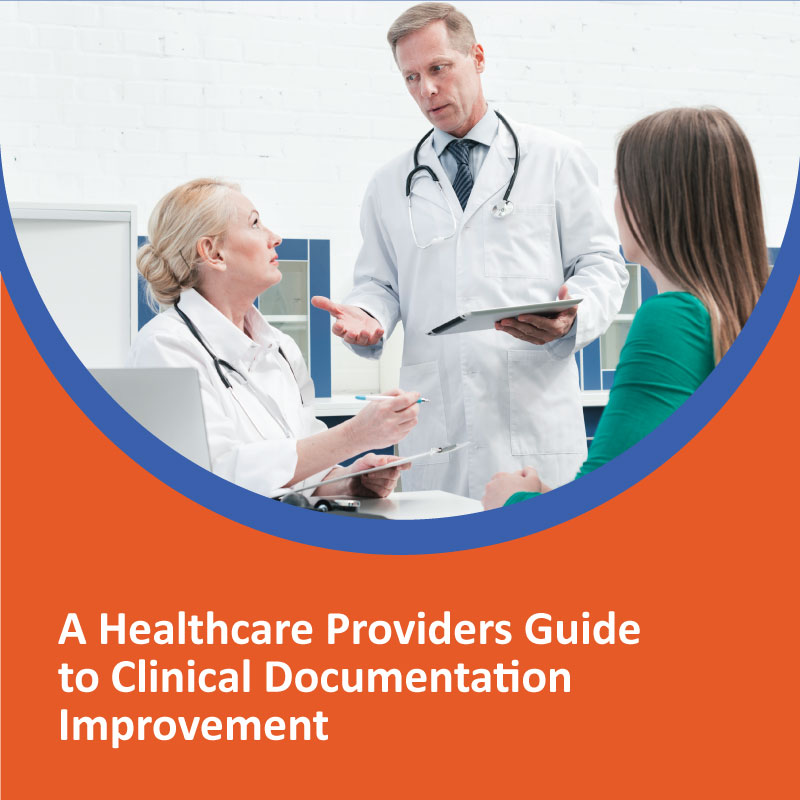Documentation becomes essential for effective patient care when a patient interacts with a healthcare professional. Furthermore, documentation must be timely, precise, consistent, reliable, complete, and clear to accurately reflect the patient’s condition. It needs to be clear and legible to elaborate on the patient’s disease, condition, and the extent of services provided. Here, clinical documentation improvement (CDI) plays a vital role in ensuring the accuracy of a patient’s clinical status, translating it into coded data. This data is converted for various purposes, such as public health data, reporting, reimbursement, physician report cards, disease tracking, and medical research.
Clinical Documentation Improvement
A well-structured CDI program contributes significantly to the accuracy of healthcare documentation. By highlighting clarity, consistency, completeness, precision, reliability, timeliness, and legibility, CDI programs ensure that patient data is accurately represented and contributes meaningfully to healthcare processes.
What is CDI?
CDI billing, also known as clinical documentation improvement. It is the process of enhancing healthcare records to bring about:
- Better patient outcomes
- Ensure top-notch data quality
- Secure accurate reimbursement.
The genesis of CDI programs in hospitals traces back to the introduction of DRGs (Diagnosis Related Groups) as a means of reimbursement.
In simpler terms, CDI focuses on making healthcare records more precise, accurate, and beneficial for patients and healthcare providers. It’s like giving the paperwork a makeover to capture a precise picture of a patient’s health journey.
Characteristics of Good Clinical Documentation
Let’s talk about what makes clinical documentation stand out:
1. Clarity
Ensuring that the documentation is clear and easily understandable by healthcare professionals is vital for effective communication and decision-making.
2. Precision
Precision in detailing patient information and medical events is essential for accurate diagnosis, treatment, and overall healthcare management.
3. Consistency
Consistency in recording information helps create a coherent and reliable patient history, facilitating better collaboration among healthcare providers.
4. Timeliness
Timely documentation is essential for:
- Real-time access to patient information
- Enabling prompt decision-making
- Efficient healthcare delivery.
5. Measurability
The ability to accurately measure and then track the effectiveness of clinical documentation over time is essential for ongoing improvements and adapting to evolving healthcare needs.
CDI plays a significant role in promoting these characteristics within clinical documentation. CDI enhances healthcare records, positively impacting patient care, data quality, and reimbursement accuracy.
Importance of CDI (Clinical Documentation Improvement)
Clinical documentation improvement (CDI) is a thorough and collaborative system within a hospital involving various disciplines. Its primary goal is to combine the necessary terminology to accurately translate a patient’s condition into medical codes. By integrating documentation, clinical care, and coding processes, CDI ensures accurate quality scores, appropriate reimbursement, and well-informed decision-making. These streamlined processes contribute directly to promoting high-quality patient care.
In essence, CDI goes beyond paperwork—it directly impacts patient care by providing essential data to the patient care team and other healthcare professionals involved in patients’ well-being at different times. This consistent approach ensures that the information is accurate and readily available, fostering a seamless scale of care for patients.
Now, let’s clarify some of the most recurring questions regarding clinical documentation improvement:
What is the full form of the CDI document?
The complete form is clinical documentation integrity (CDI). Despite being a vital part of patient treatment, CDI documentation often stays under the radar in the broader healthcare landscape.
What is a CDI Query?
A CDI query is a communication tool between a CDI Specialist/Coder and a physician. Its purpose is to address unclear, incomplete, or conflicting information in the medical record.
Who is a CDI Specialist?
Clinical documentation improvement (CDI) specialists are professionals essential to the CDI program. They use specific terminology to translate a patient’s condition into precise codes. These specialists delve into intricate healthcare reimbursement details, ensuring proper documentation for effective patient care. Collaboration with physicians and coding staff is essential for a smooth CDI process. Additionally, CDI specialists play a role in educating the patient care team about the guidelines for medical record documentation.
How Can Clinical Documentation Be Improved?
The following are some practical ways to enhance clinical documentation in 2024:
1. Team Education
If productivity is affected by inaccurate, incomplete, or confusing documentation, consider additional training for your staff. Ensuring everyone in your business understands documentation is important. Some team members may need to revisit the basics, and educational decisions should be based on test results from communication and reporting assessments. The primary goal of education and retraining is to clear up any misunderstandings or uncertainties in reporting.
2. Assess Communication
Ensure that your organization’s CDI staff, physicians, and coders communicate effectively. If issues persist, they need to be addressed timely. Communication assessment aims to identify areas of miscommunication among these groups, which may result from using illegible or unfamiliar shorthand. Clarifying shorthand or avoiding it entirely is essential for resolving this issue.
3. Reduce Shorthand
One of the primary goals of communication assessment is to identify areas of miscommunication. This can be caused by using illegible or unfamiliar shorthand. Since shorthand is effective only when all parties understand its meaning, clarifying shorthand-written words or avoiding them entirely is crucial to prevent misunderstandings or inaccuracies.
4. Collecting Patient Information Accurately
During the patient screening procedure, gather complete demographic and insurance data. A reliable claims process relies on accurate patient data. Obtaining a copy of the patient’s insurance card is also important. Asking for a duplicate at each visit and comparing it to the information in your system is the best practice for repeat customers. Clinics not following this procedure may experience claim denials due to incorrect patient demographic data. If your clinic notices an increase in denials or a consistent pattern, there might be an issue with intake procedures.
Providing feedback to front desk employees after claim denials enables them to identify the basic causes, make necessary corrections, and gather essential data for future clean claims.
Purpose of CDI Programs (Clinical Documentation Improvement)
A clinical documentation improvement program is a method put into action to achieve precise and comprehensive medical record documentation.
Why are CDI programs necessary?
Electronic health record (EHR) systems have made it easier for providers and hospitals to handle administrative tasks related to patient care and claim submission. Nevertheless, the duty of medical record documentation—the recording of clinical information about the care provided to a patient—always rests with the medical provider.
To support providers in this responsibility, a CDI specialist takes on the task of reviewing a patient’s medical records. The aim is to ensure that the documentation accurately reflects the specifics of current conditions, allowing for the precise coding of the patient’s health status.
Importance of Clinical Documentation Improvement in Patient Care
An effectively practiced CDI holds significant importance in a patient’s healthcare journey for the following:
1. Legal Situations
In certain situations, clinical notes may serve as legal documentation. While practitioners aim to avoid negligence or clinical negligence lawsuits, having the necessary paperwork in place is essential. Being prepared can be crucial in legal matters concerning patient care.
2. Patient Satisfaction
The healthcare sector is shifting towards a consumer-based care model, prioritizing patient needs and preferences. Focusing on patient satisfaction is a key principle in this model. Today, more patients are seeking transparency in their treatments. A robust CDI is vital in achieving patient satisfaction by providing clarity and openness inside patient treatments.
Important Tips to Improve Clinical Documentation Compliance
Whether your organization is contemplating a clinical documentation improvement program or facing compliance challenges, here are five best practices for success:
1. Handle the pre-work before kicking-off the CDI program
Before starting a Clinical Documentation Improvement (CDI) program:
- Review a sample of records to identify areas for improvement.
- Focus efforts on these areas for measurable change, illustrating how enhanced documentation benefits patients, practices, or populations.
- Educate providers beforehand, emphasizing the value the program places on their skills and time.
- Foster collaboration between physicians and coders for more efficient and effective work.
2. Find a Champion of a Physician
A respected physician’s understanding of the program’s goal is a key asset for a successful launch. This individual, known as the “golden chip,” supports the mission of the CDI program and can advocate for it among colleagues.
3. Review the Record Before a Patient Visit
A clinical documentation specialist can assess the medical record before a patient visit to identify potential issues and compliance opportunities. More clinical than traditional coding, this forward-thinking approach contributes to a comprehensive understanding of the patient’s condition.
4. Set Up Processes
Establish a policy where a CDI specialist can review bills with targeted codes before submission to ensure code accuracy. If there’s uncertainty, the specialist can assess if the documentation supports the diagnosis, making necessary code changes. The goal here is to capture the patient’s story and resources provided during their visit while maintaining compliant coding.
5. Leverage Technology
Implementing appropriate tools can enhance efficient and accurate documentation, starting at the point of care. Provider-focused intelligence tools embedded in the Electronic Health Record (EHR) can streamline searches and guide physicians to the most specific diagnosis code.
Conclusion
Quality clinical documentation is fundamental for healthcare organizations reliant on coded data for quality reporting, accurate reimbursements, and improved patient outcomes. The MedICD team can help with clinical documentation improvement wherever you are in your journey. Invest in CDI for a comprehensive makeover of patient health records and a seamless healthcare experience.



